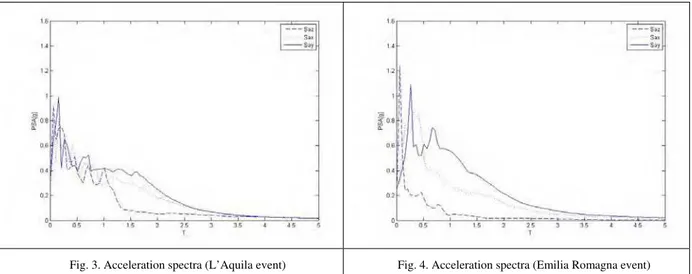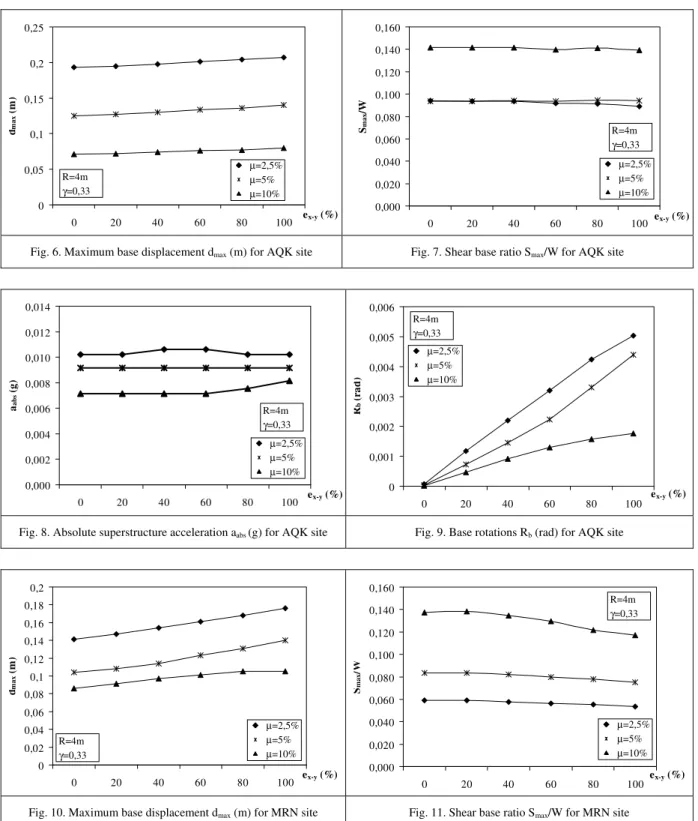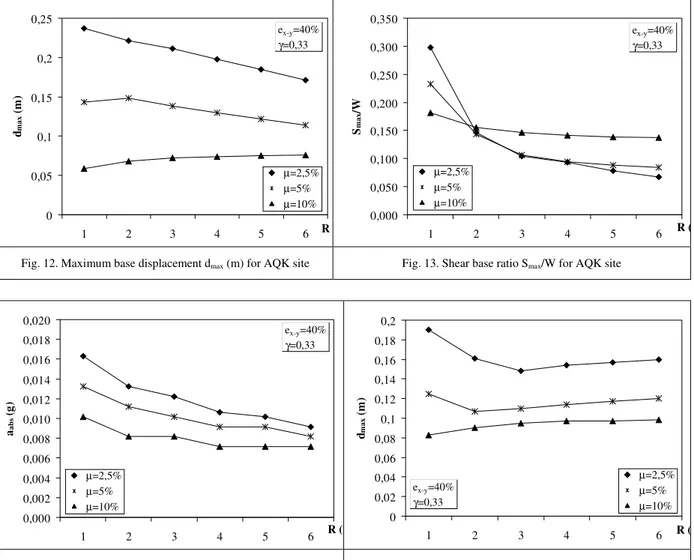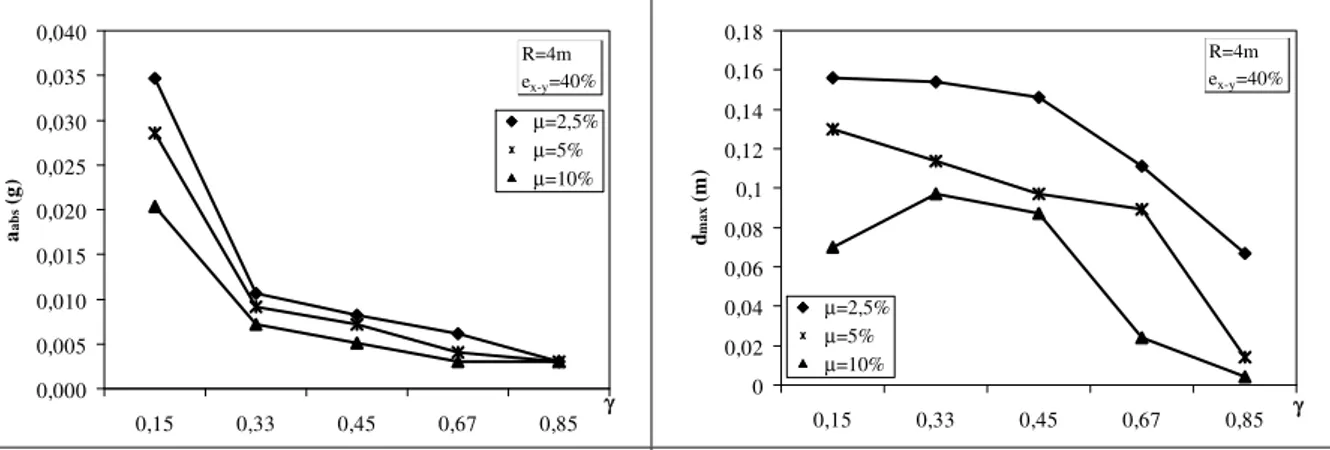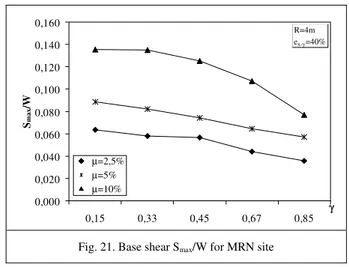Analysis Of Seismic Performance Of Fps
Base Isolated Structures Subjected To Near
Fault Events
Luigi Petti, Fabrizio Polichetti, Bruno Palazzo
Dipartimento di Ingegneria Civile dell’Università degli Studi di Salerno Via Ponte Don Melillo, 84084 Fisciano (Salerno), Italia
petti@unisa.it fabriziopolichetti@email.it
palazzo@unisa.it
Abstract - The paper examines the seismic behaviour of base isolated structures with friction pendulum
slide bearing devices subjected to near fault events characterized by significant vertical ground motion components. In particular, in order to evaluate the effects of the mass eccentricity, of the ratio between the superstructure mass and the overall mass system, of the bearing radius of curvature and of the friction on the seismic response, non-linear dynamic analysis, carried out by using MDOF numerical model, have been performed by considering two near-fault seismic events, L’Aquila 2009 and Emilia Romagna 2012. The results obtained show that mass eccentricity do not influence significantly the main seismic response parameters, while the mass ratio, the friction coefficient and the radius strongly affect the seismic behaviour of the base isolated structures.
Keywords - base isolation, friction pendulum bearings, vertical ground motion, mass eccentricity
I. INTRODUCTION
Nowadays, more new isolator types have been developed as an alternative to the multilayer elastomeric devices, such as friction slide bearings (FPBs) which exploit the properties of the friction and lead to high affordability and very high fundamental periods by means of cheap devices. The FPBs have characteristics of high rigidity to wind and minor to earthquake loads. Moreover may have high vertical load capacity and stability.
The functional principle of the friction pendulum bearings is simple: a spherical sliding surface which realizes a pendulum system whose fundamental period is related essentially to the length of the pendulum, otherwise the radius of curvature of the spherical sliding surface, and therefore the dynamic response of these bearings is strictly related to the friction behavior [1]-[2]-[3].
Differently from elastomeric bearings, the friction pendulum bearing behavior can be affected by vertical loads, considering that the lateral stiffness is correlated to the friction forces, which not only depend on the friction coefficient and the radius of the curvature of the FPB’s sliding surface but also on the vertical load. The consequences are that base isolated structures with FPBs can show superstructure behavior, i.e. story accelerations and shear, worse than those obtained with elastomeric bearings.
Some studies in literature have investigated different friction pendulum systems. For the case of FPBs subject to vertical motion components, it seems worth mentioning the research done by Constantinou [4] about the interaction between the orthogonal components of the frictional force at the sliding interface, the numerical tests on a rigid frame model conducted by Whittaker [5], showing that the effect of vertical shaking on the force and displacement response is negligible. Indeed, the research done by Khoshnoudian and Hagdoust [6] has proven that the interaction between the stiffness of the two horizontal directions reduces structural shear and base shear, but thevertical component of an earthquake considerably affects lateral responses, as well as Petti and Polichetti [7].
Moreover, the structures isolated with the FPBs are also subjected to the stick-slip effect. Stick-Slip motion is the basis for the description of a great variety of phenomena characterized by the presence of sliding friction between bodies with elastic features. In this case, the dynamic structure is characterized by alternating phases: “static” phases where the system accumulates potential energy and “dynamic” phases where this energy is transformed in kinetic energy. This effect is similar, in an abstract way, to the problem of the sliding motion with friction of a body with elastic properties [8]. In the case of base isolation with FPBs the Stick-Slip behaviour can affect the superstructure seismic behaviour due to the continuous hopping in the sliding motion.
bearings produced by FIP and Alga [9]. The system used is the same for all buildings: a large concrete isolated slab linked by the FPBs to the columns of the first floor connected to the ground by a substructure slab, and over the isolated slab different types of buildings (concrete, wood, steel) with free design. Each isolated system has the same period of vibration independently from the over-slab superstructure design parameters (mass etc.).
The objective of the paper is to investigate the seismic behavior of isolated systems by FPB devices in the case of near fault events characterized by high values of vertical components. For this purpose the study considers a MDOF model consisting respectively of an isolated slab on which the superstructure is described by the first modal components in both the main horizontal direction. In particular the slab presents a square shape, with one FPB in each corner, and the mass describing the superstructure is considered with different eccentricities with regard to the mass and stiffness centers of the slab. The paper investigates the seismic response of the model by considering the influence of the friction, the mass eccentricity, the mass ratio and in case of the near fault events of L’Aquila 2009 and Emilia Romagna 2012 characterized by strong local directivity effects [10]-[11].
II. THE FRICTION PENDULUM BEARINGS
The FPB consists of a spherical sliding surface and an articulated slider which is faced with a high pressure capacity bearing material. The bearing, which realizes a pendulum system, may also be installed upside-down with the spherical surface facing down rather than up. In both installation methods the behaviour is identical. A cross section view of an FPBs is shown below.
Fig. 1.Friction Pendulum system [12]
In particular, a friction pendulum system is constituted by a swivel slider that oscillates around the center of curvature of a concave spherical surface whose radius R is equivalent to the pendulum length.
a)
b)
One of the most important properties of FPB isolated systems is that the fundamental period of vibration
T
R of the isolated system is independent of the overall mass [5] and can be evaluated by the pendulum behavior as:R/g
2
π
T
R=
(1)The lateral force provided by an FPBs is directly proportional to the weight
W
it carries and, thus, generally the isolation system force always develops at the center of mass of the supported structure if overturning effects and vertical behavior are neglected. For the single bearing, the friction force is equal to:ϑ
µ
W
cos
F
a=
(2)which leads, by considering the rotational equilibrium, to the following horizontal restoring force
F
:R
F
R
W
R
F
⋅
cos
ϑ
=
⋅
sin
ϑ
+
a⋅
ϑ
ϑ
µ
ϑ
ϑ
cos
cos
cos
sin
R
WR
R
WR
F
=
+
(3)where
µ
is the dynamic friction coefficient,D
the horizontal displacement,W
the vertical load and R the radius of the curvature of the bearing.In the case of small oscillations, low values of the ratio
D
/
R
, the relationship between the restoration force and displacement (fig. 2) can be write as:D
R
W
W
F
=
µ
+
(
/
)
(4)As figure 2 shows, real FPB device presents initial elastic stiffness due to the constitutive material behavior. Instead, the secant stiffness can be evaluated in correspondence of the maximum displacement
D
max as:max
/
D
F
K
eff=
(5)The Eq. (5) show that the efficient stiffness of the base isolated system with FPBs increase by increasing the weight
W
.Therefore, the effective fundamental vibration period
T
eff does not coincide with the reference periodT
Revaluated from pendulum behavior being:
g
K
W
T
eff=
2
π
/
eff (6)The effective damping provided by a friction isolator is equal to the integer of the hysteresis cycle area [4]:
[
/(
/
)
]
)
/
2
(
D
R
B
=
π
µ
µ
+
(7)III. CONSIDERED SEISMIC EVENTS
The L’Aquila 2009 and Emilia Romagna 2012 near fault events have been considered in the analysis. Magnitude and Peak Ground Acceleration (PGA) for horizontal (X and Y) and vertical (Z) components are represented:
TABLE I
Considered Events, Seismic Parameters
Pga (g)
ID station Mw PGANS PGAEW PGAv
L’Aquila 06/04/2009 AQK Station
6,3 0,34 0,34 0,35
Emilia Romagna 20/05/2012 MRN Station
6,0 0,26 0,26 0,30
Fig. 3. Acceleration spectra (L’Aquila event) Fig. 4. Acceleration spectra (Emilia Romagna event)
The considered seismic events are characterized, as shown in [10]-[11], by strong local directivity effects.
IV. MODEL
To evaluate the response of base isolated a M-DOF model is described in SAP 2000 (Fig. 5). The model consists of a superstructure, described by the first modal shapes in both the horizontal directions, isolated by a rigid square plate supported by 4 ground-linked FPS bearings. In particular, the superstructure’s main periods in both horizontal directions are 0,4sec and the base plate has size 6m x 6m.
In the model the rigid plate at base is considered by a lumped mass (
m
b) set in the geometrical center. Thesuperstructure is modeled, instead, by considering a 2-DOF lumped mass (
m
s), representing the first modalshapes in both the main horizontal direction. The mass
m
s is connected to the base by a frame high 6m witheccentricities (
e
x-y) varying in both the horizontal directions. The total weight of the system is assumed equal to 6000 kN and the mass ratioγ
, between the superstructure weight and the total weight, is considered varying in the range 0,15-0,85.The FPB devices are described by a biaxial friction pendulum model in Sap 2000, NonLinear Link, named “Friction Isolator” [13]. This link leads to coupled friction properties for the two horizontal shear deformations, post slip stiffness due to the pendulum radii and no tension capacities. In particular, the friction forces are described by hysteretic behavior of Wen and Nagarajaiah [14]-[15]-[4]. Although the considered model leads to velocity variable friction coefficients, the analyzed cases assume constant values.
ey
ex
6m 6m
mb
ms
FPS FPS
FPS FPS
Fig. 5. Sap 2000 M-DOF model
V. NON LINEAR ANALYSIS AND RESULTS
by varying radii
R
(1-6m), friction coefficients µ (0,025-0,10) and mass eccentricitye
x-y valued as a percentage of the mid-length of the model side (0-100%).Figures 6-9 plot the maximum response of the system to L’Aquila 2009 event (AQK) in terms of base displacements (
d
max), base in plane rotations (R
b), base shear (S
max/
W
) and absolute accelerations of thesuperstructure (
a
abs). The seismic behaviour has been represented by varying the mass eccentricitye
x-y andhaving considered
R
=4m andγ
=0,33. Figure 10-11 plot the same results for the Emilia Romagna 2012 event (MRN).Results clearly show that the mass eccentricity does not significantly influence the system response in terms of displacement, shear and acceleration. Moreover, the base in plane rotations are negligible.
0 0,05 0,1 0,15 0,2 0,25
0 20 40 60 80 100 ex-y (%)
d ma x ( m ) R=4m γ=0,33 µ=2,5% µ=5% µ=10% 0,000 0,020 0,040 0,060 0,080 0,100 0,120 0,140 0,160
0 20 40 60 80 100 ex-y (%)
S ma x /W R=4m γ=0,33 µ=2,5% µ=5% µ=10%
Fig. 6. Maximum base displacement dmax (m) for AQK site Fig. 7. Shear base ratio Smax/W for AQK site
0,000 0,002 0,004 0,006 0,008 0,010 0,012 0,014
0 20 40 60 80 100 ex-y (%)
a ab s ( g ) R=4m γ=0,33 µ=2,5% µ=5% µ=10% 0 0,001 0,002 0,003 0,004 0,005 0,006
0 20 40 60 80 100 ex-y (%)
R b ( ra d) R=4m γ=0,33 µ=2,5% µ=5% µ=10%
Fig. 8. Absolute superstructure acceleration aabs (g) for AQK site Fig. 9. Base rotations Rb (rad) for AQK site
0 0,02 0,04 0,06 0,08 0,1 0,12 0,14 0,16 0,18 0,2
0 20 40 60 80 100 ex-y (%)
d ma x ( m ) R=4m γ=0,33 µ=2,5% µ=5% µ=10% 0,000 0,020 0,040 0,060 0,080 0,100 0,120 0,140 0,160
0 20 40 60 80 100 ex-y (%)
Sma x /W R=4m γ=0,33 µ=2,5% µ=5% µ=10%
Figures 12-16 plot the behaviour of isolated system by varying the radius of the curvature
R
of FPB in the case ofγ
=0,33 ande
x-y= 40%.Figure 12 shows that, in the case of AQK event, the maximum base displacements decrease by increasing the radius when friction coefficient of FPB is less than or equal to 5%. Instead, high values of friction (
µ
=10%) lead to an increase in the displacements. In the case of MRN event (Fig. 15), the behaviour seems to be more complex, in particular for low values of friction coefficient where it is possible to find a minimum response when R=2-3m.Figures 13 and 16 show that the base shear decrease by increasing
R
, slowly for high values of the friction leading to an intersection of the curves for small values of radiusR
.Results could be explained considering the FPB isolators behaviour (eq. 4): for high values of the radius
R
the termD
/
R
decreases and the friction coefficientµ
plays the main rule in the shear response; instead, forsmall radius
R
both the termsD
/
R
andµ
affect the shear.Figure 14 shows that the superstructure absolute accelerations decrease by increasing the friction coefficient
µ
and the radius of the curvatureR
.0 0,05 0,1 0,15 0,2 0,25
1 2 3 4 5 6 R
d
ma
x
(m
)
µ=2,5% µ=5% µ=10% ex-y=40%
γ=0,33
0,000 0,050 0,100 0,150 0,200 0,250 0,300 0,350
1 2 3 4 5 6 R (
S
ma
x
/W
µ=2,5% µ=5% µ=10%
ex-y=40%
γ=0,33
Fig. 12. Maximum base displacement dmax (m) for AQK site Fig. 13. Shear base ratio Smax/W for AQK site
0,000 0,002 0,004 0,006 0,008 0,010 0,012 0,014 0,016 0,018 0,020
1 2 3 4 5 6 R (m
a
ab
s
(
g
)
ex-y=40%
γ=0,33
µ=2,5% µ=5% µ=10%
0 0,02 0,04 0,06 0,08 0,1 0,12 0,14 0,16 0,18 0,2
1 2 3 4 5 6 R (
d
ma
x
(m
)
µ=2,5% µ=5% µ=10% ex-y=40%
γ=0,33
0,000 0,050 0,100 0,150 0,200 0,250
1 2 3 4 5 6 R (m)
S
ma
x
/W
µ=2,5% µ=5% µ=10%
ex-y=40%
γ=0,33
Fig. 16. Shear base ratio Smax/W for MRN site
Figures 17-21 plot the behaviour of isolated system by varying the mass ratio in the case of R=4 and
e
x-y= 40%. In particular, Figure 17 and Figure 20 show that the maximum base displacement are strongly influenced by the mass ratioγ
. Generally, by increasing the ratioγ
the base displacement decrease with exception forlow values of friction coefficient where the response increase slightly for
γ
≤
0
,
5
.Figure 18 show that, in the case of AQK event, the base shear increase by increasing the mass ratio
γ
up to 0,67, and decrease for higher values. Figure 21 shows, instead, a more regular trend for MRN seismic event.Figure 19 shows that the absolute superstructure acceleration, in the case of AQK event, quickly decrease by increasing the mass ratio.
0 0,05 0,1 0,15 0,2 0,25
0,15 0,33 0,45 0,67 0,85 γ
dm
ax
(m
)
µ=2,5% µ=5% µ=10%
R=4m ex-y=40%
0,000 0,050 0,100 0,150 0,200 0,250
0,15 0,33 0,45 0,67 0,85 γ
S
ma
x
/W
µ=2,5% µ=5% µ=10%
R=4m ex-y=40%
Fig. 17. Maximum base displacement dmax (m) for AQK site Fig. 18. Base shear Smax/W for AQK site
0,000 0,005 0,010 0,015 0,020 0,025 0,030 0,035 0,040
0,15 0,33 0,45 0,67 0,85 γ
a
ab
s
(
g
)
µ=2,5% µ=5% µ=10%
R=4m ex-y=40%
0 0,02 0,04 0,06 0,08 0,1 0,12 0,14 0,16 0,18
0,15 0,33 0,45 0,67 0,85 γ
d
ma
x
(m
)
µ=2,5% µ=5% µ=10%
R=4m ex-y=40%
0,000 0,020 0,040 0,060 0,080 0,100 0,120 0,140 0,160
0,15 0,33 0,45 0,67 0,85 γ
Sma
x
/W
µ=2,5% µ=5% µ=10%
R=4m ex-y=40%
Fig. 21. Base shear Smax/W for MRN site
VI. CONCLUSIVE REMARKS
The paper investigated the seismic response of base isolated structures with friction pendulum slide bearings devices subjected to near fault events. To evaluate the effects of the mass eccentricity, of the mass ratio
γ
, of the bearing radius of curvature and friction on the seismic response, non-linear dynamic analysis by MDOF numerical model have been performed, considering both horizontal and vertical seismic components.The analyses show the negligible influence of the mass eccentricity on the seismic response, while the mass ratio, the friction coefficient and the radius produce strong effects on the seismic behaviour. In particular, high values of friction coefficient reduce the maximum base displacement and increase the base shear, while high and low values of mass ratio are not indicated for efficient isolation system.
The increase of the radius of curvature reduce the maximum base shear and the maximum base displacements up to 25% for the considered seismic events. In particular, for high values of the radius
R
the friction coefficientµ
plays the main rule in the shear response; instead, for small radiusR
, the shear is influenced more by the ratio between the radius and the displacement.REFERENCES
[1] Victor A. Zayas, Stanley S. Low, and Stephen A. Mahin (1990), A Simple Pendulum Technique for Achieving Seismic Isolation. Earthquake Spectra: May 1990, Vol. 6, No. 2, pp. 317-333.
[2] A.S. Mokha, M.C. Constantinou, A.M. Reinhorn, Verification of Friction Model of Teflon Bearings Under Triaxial Load, J.Struct. Eng. 1993.119:240-261.
[3] Mokha, A., Constantinou, M., and Reinhorn, A. (1990), Teflon Bearings in Base Isolation I: Testing, J. Struct. Eng., 116(2), 438–454. [4] S. Nagarajaiah, A. M. Reinhorn, and M. C. Constantinou, 3D-Basis: Non linear Dynamic Analysis of Three- Dimensional Base Isolated Structures: Part II, Tecnical Report NCEER- 91- 0005, National Center for Earthquake Engineering Research, State University of New York at Buffalo,Buffalo, N.Y. 1991
[5] G.Mosqueda, A.S.Whittaker, G. L.Fenves, Characterization and Modeling of Friction Pendulum Bearings Subjected to Multiple Components of Excitation, J.Struct.Eng. 2004:130:433-442,2004
[6] G F. Khoshnoudian, V. Rezai Hagdoust, Response of Pure-Friction Sliding Structures to Three Components of Earthquake Excitation Considering Variations in the Coefficient of Friction, Civil Engineering, Vol. No.6, pp. 429-442, 2009
[7] L. Petti, F. Polichetti, A. Lodato, B. Palazzo, Modelling and Analysis of Base Isolated Structures with Friction Pendulum System Considering Near Fault Events, OJCE, Scientific Research Publishing (SCIRP), Volume 3, N. 2, June 2013
[8] Leine R. I., Van Campen D. H., De Kraker A., Van Den Steen L., Stick-Slip Vibrations Induced by Alternate Friction Models. Nonlinear Dynamics16: 41–54. Kluwer Academic Publishers, Netherlands, 1998.
[9] http://www.protezionecivile.gov.it/jcms/it/view_dossier.wp?contentId=DOS274
[10] L.Petti, I. Marino, Preliminary comparison between response spectra evaluated at close source for l’aquila earthquake and elastic demand spectra according to the new seismic italian code, Report ReLuis 2009
[11] L.Petti, A. Lodato, Preliminary spatial analysis and comparison between response spectra evaluated for Emilia Romagna Earthquakes and elastic demand spectra according to the new Seismic Italian Code, Report ReLuis, 2012
[12] Nistir 5800, Guidelines for Pre-qualification, Prototype and Quality Control Testing of Seismic Isolation System,1993 [13] CSI Analysis Reference Manual, SAP 2000, Berkeley, California, USA
[14] Y. K. Wen, Method for Random Vibration of Hysteretic Systems, Journal of the Engineering Mechanics Division, ASCE, Vol. 102, No. EM2, 1976
![Fig. 1. Friction Pendulum system [12]](https://thumb-eu.123doks.com/thumbv2/123dok_br/16407413.194126/2.892.292.621.456.566/fig-friction-pendulum-system.webp)
